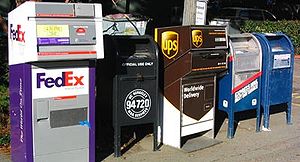The US Postal Service (USPS) has been in the news a lot lately. They have been losing money and recently defaulted on a future-retiree health-care payment to the U.S. Treasury.

Image taken by User:Minesweeper on December 14, 2003 and released into the public domain. From left to right, the post boxes belong to FedEx Corporation, University of California, Berkeley, United Parcel Service, and two from the United States Postal Service (the one on the left is for Express Mail only) (Photo credit: Wikipedia)
The USPS has been losing $25 million a day due to a decline in people using its mail services. The Internet has taken a large portion of its business. To stem the loss, there are proposals to close offices, reduce deliveries, and reduce the workforce. All of these changes will make mail an even less attractive delivery mode, and probably reduce future business even more.
Why we need mail
The USPS delivers mail virtually anywhere for a low cost. While letter writing and bill payments have moved into the electronic world, there are still times that a delivery is needed. Personally, my favorite things to mail are greeting cards. It shows thought and effort beyond a simple line of text in an email.
According to the Direct Marketing Association, printed direct mail in 2012 is forecast to return between $7.25 and $15.40 for every dollar spent by businesses. While this is lower than commercial email campaigns, it is a profitable and effective tool for direct marketing. For certain target audiences, for example in rural areas or for elderly consumers, printed direct mail may be the only option because the Internet is either unavailable or unfamiliar.
Why the USPS is wrong
Senator Bernie Sanders (I, VT) has said that he has concerns that USPS is pressing to make modifications that would hurt rural communities and eliminate jobs. The competitive edge of the post office is their low cost and high service level. The business model of cut, cut, cut is leading the post office to close.
“At a time when the Postal Service is facing very significant financial problems from email and the Internet, slowing down mail delivery service does not make any sense at all,” Sanders said.
No other service will deliver a letter to anywhere in the country for 47¢. Even at twice the price, the cost is still the lowest of any delivery service.
Doubling the cost of postage will make many people upset. But so will closing the post office. The USPS needs to look at their competitors and their place in the market. They have a captive market of low-cost delivery to every household.
Although large price increases (near doubling) will hasten the departure of some customers to move more quickly to online bill pay or electronic document delivery, these customers were headed there already.
What we can learn
We all can and must update our market position in the changing business world. Are we still in the same business and same position as we were five or ten years ago? How has our business changed, and how have our customers and their needs changed?
Resources
Direct Mail ROI http://printinthemix.com/Fastfacts/Show/560
http://thehill.com/blogs/on-the-money/budget/208985-sanders-leads-push-to-change-senate-postal-bill





Why the Post Office is wrong and how we can learn from them. | Change Conversations http://t.co/9M1WuysR